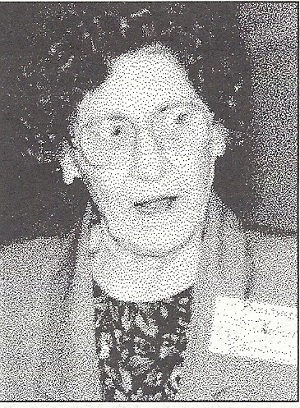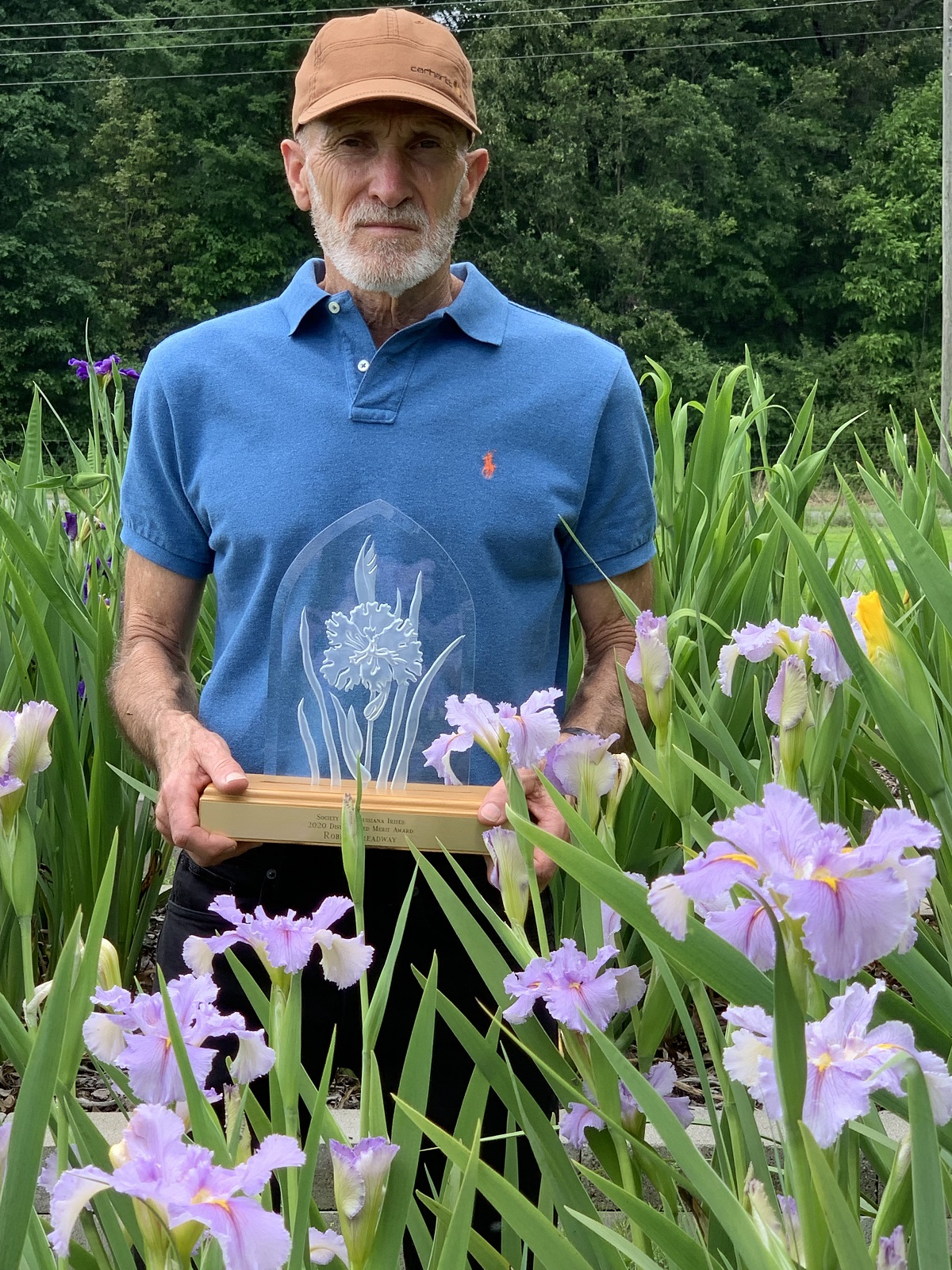By Joseph K. Mertzweiller
ABSTRACT: Tetraploid Louisiana iris pioneer Joseph K Mertzweiller is now involved in a complex process called interploidy hybridizing – the attempt to produce new tetraploids through diploid X tetraploid crosses. Although complicated, this is the process used by bearded iris hybridizers to convert that class of plants to tetraploids earlier in this century. Results of the author’s program thus far indicate that seed production is extremely difficult and germination is poor. Offsetting the difficulties, however, is the possibility of including new diploid-originated genetic material into tetraploid strains.
Augmenting the chemical methods of inducing tetraploidy, there is also a route which involves hybridizing. This requires crossing iploids with tetraploids (or reciprocal) to produce tetraploids by a rather complex mechanism. According to all genetic and botanical authorities, the method is very difficult but can be very effective in expanding genetic variability since it combines the diploid genes with the tetraploid genes.
The complexity is great because several different hybridizing mechanisms can occur. The desired mechanism to produce tetraploids requires a failure of normal sex cell formation (reductive cell division) in the diploid parent. So the diploid parent plays a much more important role than the tetraploid parent. Normally the diploid (2n) forms n sex cells by reductive cell division; combination of the normally- reduced n sex cells on fertilization gives normal 2n diploid progeny. A tetraploid (4n) normally forms 2n sex cells and regenerates the tetraploid on fertilization. But reductive cell division very rarely fails to occur in the diploid (probably in tetraploid also, but this does not matter). When this happens the diploid sex cells are 2n rather than n. Possibilities on fertilization are:
2n Unreduced egg cell from Diploid + 2n Normal Reduced Pollen Cell from Tetraploid = 4n Seedling Tetraploid
2n Normal Reduced Egg Cell from Tetraploid + 2n Unreduced Pollen Cell from Diploid = 4n Seedling Tetraploid
Suffice it to say that formation of unreduced gametes is very rare in most plants and the frequency of formation is unknown. The complexity is that several other paths are possible; these include diploid formation (uncertain mechanism) and triploid formation by a normal combination of n + 2n or 2n +n sex cells. Triploids are rare in the genus Iris because of a natural “block” apparently associated with the infertility of triploids. But it does happen that iploids, triploids and tetraploids can result when diploid irises are crossed with tetraploids (or reciprocal).
In view of all these problems, why should one consider the interploidy hybridizing route to tetraploids? Simply because this is the exact route that produced tetraploid bearded irises and was responsible for the remarkable transition from diploids to tetraploids earlier in this century. This is often cited as one of the most remarkable achievements in botanical science.
About the turn of the century bearded iris hybridizers in Europe began to despair because of lack of progress. Bearded irises of that period were based on European species, all of which were diploid – although nothing about genes, chromosomes and ploidy levels was known at that time. These hybridizers had missionaries collect bearded irises in the wild in the eastern Mediterranean countries (modern Syria, Iraq, Iran and Israel) and also in Asia. These irises were “different,” mostly blue and white and much larger and taller than the European hybrids. They turned out to be tetraploids, but this was unknown at the time. Available records indicate the hybridizers experienced much difficulty in getting the new “species” to cross with the European cultivars and species. This is very understandable given several decades of hindsight. The European hybridizers were doing interploidy hybridizing although they were unaware of it. However they persisted in their efforts and in about four decades the tetraploids completely superseded the diploids. Today’s bearded irises are completely stabilized and highly inter-fertile.
Possibly the most outstanding example of interploidy hybridizing is the bearded iris SNOW FLURRY which resulted from a 4n X 2n cross. An nreduced male gamete or pollen cell was involved. According to iris lore the pod contained two seeds, one of which germinated. Many hybridizers consider SNOW FLURRY the most important iris parent of all time. It is in the parentage of a great many Dykes Medal winners, possibly more than any other bearded iris.
My own work in interploidy hybridizing began very recently, in 1987. This now represents more than 60 percent of my hybridizing effort, and involves more than 200 pollinations, 2n X 4n and 4n X 2n each season. As professional botanists and geneticists have indicated, it is extremely difficult to produce results. Five years of effort is hardly enough for anything but the most preliminary indications. I am striving for the following: (1) Quality iris, preferably tetraploids, (2) statistical data regarding the degree of difficulty to produce seedlings by this method, and (3) evaluations as to ploidy levels.
Without going into extensive details, results thus far indicate it to be 100-150 times more difficult to produce a 2n X 4n seedling than the typical 2n X 2n seedling; for a 4n X 2n seedling, the degree of difficulty is much greater, 400-500 times. These results take into account both probability of sound seed production and extent of germination. The extent of germination is very important. Not only is it difficult to produce sound seeds, but germination is on the order of 15-20 percent for 2n X 4n seed and only about 5 percent for 4n X 2n. Although it may be possible to enhance germination, the methodology will require intensive effort. When sound seed are produced the general result is for only 1-3 sound seeds per pod, reminiscent of the case of SNOW FLURRY In the event of more seed per pod, which is very rare, one needs be suspicious of contamination, particularly in 2n X 4n hybridizing.
At the end of 1990, a total of 51 interploidy seedlings were growing, 45 from 2n X 4n but only 6 from 4n X 2n. This further confirms the dramatic difference between the two categories of interploidy hybridizing. As pointed out, much of this difference is due to poorer germination of 4n X 2n seed.
Eleven of these plants bloomed in 1990-1991, ten from 2n X 4n and one from 4n X 2n. Nine are considered diploid as evidenced by compatibility (as pollen parent) with diploids and lack of compatibility with tetraploids. Two showed almost complete lack of compatibility with both diploids and tetraploids. There is a good possibility that both of these could be triploid but further verification is needed. While lack of compatibility with tetraploids is disappointing there are 40 plants yet to bloom. Two of these (both 4n X 2n) are blooming size and have foliage texture characteristic of tetraploids. All plants have been dug and replanted and are making excellent growth at this time.
One of the 1990 blooms (2n X 4n) is a magnificent, near 7″ bicolor, beige yellow standards and rose-red falls. This iris (INT-DT 87-34) is described in detail and pictured in the September, 1990 Newsletter (No. 141). Parentage is COLORIFIC (diploid) X C75-26A (tetraploid seedling from PROFESSOR Hill). It is very spectacular and a welcome addition to Louisiana bicolors, of which very few exist. The diploid nature is proven by more than a hundred seedlings from quality diploid pod parents. No positive results were obtained with tetraploid pod parents.
Two 1991 interploidy blooms are described and pictured in the September, 1991 Newsletter (No.145). One is 4n X 2n and the other 2n X 4n. Test crossing was extensive with both diploids and tetraploids with little or no evidence of compatibility in all cases. This suggests the possibility of triploids, but further testing is needed. Although not as spectacular as the 1990 bicolor, the 1991 plants are quality irises.
Intercrossing irises of different ploidy levels, as difficult as it is, could have something else to offer besides potential tetraploids. Progeny, regardless of ploidy level, may be of better-than-average quality. Such is the case with the diploid bicolor. For many years I have tried to breed improved bicolors from COLORIFIC, but a hundred or more seedlings have shown no success. Then a single seedling representing an interploidy cross of COLORIFIC produced a really outstanding bicolor. There is no scientific evidence to suggest this as a general trend. However, bearded irises which came from a pod containing only one or two seeds have often shown outstanding quality.


